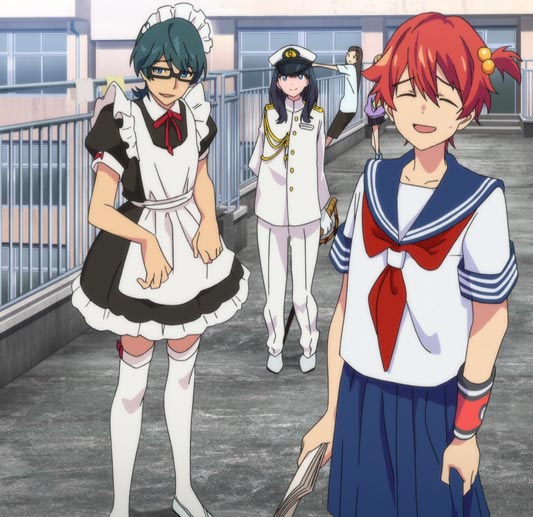There are various ways to say "crossdressing" in Japanese, depending on what you mean.
- josou
女装
Literally "female clothes," can refer to guys crossdressing. This is the most common term. - dansou
男装
Literally "male clothes," can refer to girls crossdressing. - iseisou
異性装
Literally "opposite-gender clothes," means crossdressing in general. This is the least common term.
Middle: Takarada Rikka 宝多六花
Right Hibiki Yuuta 響裕太
Anime: SSSS.GRIDMAN (Episode 8, Stitch)
Grammar
Grammatically, all three words can be used as suru-verbs.
- josou suru
女装する
(For a guy) to crossdress. - josou saseru
女装させる
To force [a guy] to crossdress. - josou saserareru
女装させられる
(For a guy) to be forced to crossdress.
- dansou suru
男装する
(For a girl) to crossdress. - dansou saseru
男装させる
To force [a girl] to crossdress. - dansou saserareru
男装させられる
(For a girl) to be forced to crossdress.
Almost every word that works for one gender has a pretty obvious opposite equivalent.
- {onna-mono no} shitagi
女物の下着
Underwear [that] {is a female-thing}.
Female underwear. - {otoko-mono no} shitagi
男物の下着
Male underwear.
Crossdresser
There are various ways to say "crossdresser" in Japanese. Using relative clauses and compound nouns, you could say:
- {josou suru} hito
女装する人
A person [who] {crossdresses [by wearing women's clothes]}.- josou suru danshi
女装する男子
A guy [who] {crossdresses}. - josou-danshi
女装男子
A crossdressing-guy.
- josou suru danshi
- {dansou suru} hito
男装する人
A person [who] {crossdressed [by wearing men's clothes]}.- {dansou suru} joshi
男装する女子
A girl [who] {crossdresses}. - dansou-joshi
男装女子
A crossdressing-girl.
- {dansou suru} joshi
Besides these, there are also specific terms for people who aren't simply crossdressing, but that are known to crossdress. For example:
- josoko
女装子
A guy who crossdresses. (as a hobby, for example.)- Pronounced josoko じょそこ with a short vowel.
- The word ko 子 generally implies a cute person.
- dansouko
男装子
A girl who crossdresses. - josou-sha, and dansou-sha
女装者, 男装者
Crosdressing person. A crossdresser. - josou-ka, and dansou-ka
女装家, 男装家
Crossdresser. (as a craft, like crossdressers that are TV personalities.)
A面, B面
There are terms to refer to the periods of time a crossdresser is crossdressing and the periods they are not.
- ee-men
A面
Side-A. (in music)
While crossdressing. (for crossdressers.)- men 面 means a face. In music, some discs are double-sided, meaning one of its faces has a set of songs, and flipping it around allows you play a different set of songs from the same disc
- bii-men
B面
Side-B. (in music)
The non-crossdressing side.- Example: his B-side is a shop clerk. Meaning: when he's not crossdressing, he's a shop clerk.
In English, similar terms are "boy mode" and "girl mode." However, note that side-B can mean either boy mode or girl mode depending on your gender, while side-A can also mean either, but it's the opposite gender instead.
Pronouns
In Japanese, there are multiple first person pronouns and some of them are used more by one gender than the other, as such, a crossdressing character may switch pronouns to fit the intended gender.
For example, ore 俺 and boku 僕 are masculine pronouns, so a girl crossdressing may use them. Girls that use the pronouns are sometimes called orekko オレっ娘 and bokukko ボクっ娘 respectively.
The pronoun watashi 私 is feminine in casual contexts, while atashi あたし and using your own name as pronoun are just feminine in general.
Breasts
The lack or presence of breasts hints one's gender, so crossdressers may make them appear out of nowhere, or disappear into nowhere, at will.
Anime: Kuragehime 海月姫 (Episode 3)
- Context: a male crossdresser pads his chest.
- ginyuu
偽乳
Fake breasts.
Anime: Mayo Chiki! まよチキ! (Episode 2)
Double
In some cases, you have a situation in which both guys and girls are crossdressing for some reason.
For example, some series feature a school event in which participants have to wear the opposite gender's clothes.
Sometimes, it's just just a character quirk.
Right: Mare Bello Fiore マーレ・ベロ・フィオーレ
Anime: Overlord, オーバーロード (Episode 1)
- Context: this trap and reverse trap pair of siblings are in-game monsters created by a player who canonically likes that sort of stuff, and probably likes heterochromia, too.
Other times it's because a complicated situation was taken to the next level by making it even more complicated.
Right: Minami Touma 南冬馬
Anime: Minami-ke みなみけ (Episode 10)
- Context: wanting to get closer to Minami Chiaki 南千秋, Makoto disguises himself as Mako-chan マコちゃん, and pretends to be one of her older sister's friends in order to get invited to their house to play. In a completely unrelated turn of events, Chiaki decides to adopt Touma as her younger brother, despite Touma being an older girl, and so Touma starts dressing as a boy, too.




No comments: